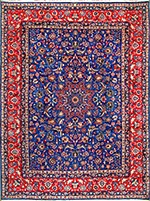Textiles Studies

Textile Research Works
Review of Eric Broug, Islamic Geometric Patterns
Date of this Version
2008
Document Type
Article
Citation
Journal of Mathematics and the Arts (2008), Volume 2, 2008 - Issue 4, Pages 206-208
doi: 10.1080/17513470802701069
Abstract
Islamic geometric patterns, by Eric Broug, London, Thames & Hudson, 2008, 120 pp., £14.95 (softcover), includes CD-ROM, ISBN 050028721X, ISBN 13 978-0500287217
Circles and their centres comprise basic starting points in the construction of intricate Islamic geometric patterns seen on monuments in many parts of the world. This tidy book provides simple, practical step-by-step instructions for how to construct Islamic geometric patterns, illustrated with line drawings and black-and-white photographs, accompanied by a CD with colour photographs of a selection of extant historic monuments. The illustrations draw from works in Iraq, Syria, Egypt, Turkey, Afghanistan, Iran, Spain, Italy, Tunisia, Morocco, Kyrgyzstan, and Pakistan. The author, Eric Broug, who is also a designer, has assembled a significant array of geometric patterns, each of which he has carefully analysed and presented for a lay audience.
Clear step-by-step instructions with sequential diagrams offer a simple system of notation to indicate construction lines and pertinent points of intersection. The diagrams direct the reader to identify line segments to express and delineate particular designs. The designs so constructed may then be repeated to form patterns. The exercises are suitable for classroom applications. The book is divided into two chapters. Chapter One, ‘The Basics’, presents basic constructions of squares, hexagons, pentagons, and combinations of shapes, with line drawings and black-and-white photographs of architectural details. Chapter Two, ‘Step-by-Step Construction’, offers instructions for constructions organized by levels of difficulty. Eight constructions are grouped as ‘easy’, four as ‘intermediate’, and seven as ‘difficult’. Line drawings provide step-by-step instructions. In general, the easy patterns require 4–8 steps, the intermediate patterns require 8–10 steps, and the most difficult recorded here require 12–20 steps for construction of the basic unit that is then repeated. The emphasis in Chapter Two is on patterns based upon squares and hexagons, each of which can be constructed using only a straightedge and compass with pencil and paper. (Note that although a ruler may be used as a straightedge, its measuring function is not required for these exercises!) For each construction, Broug cites an historical example. For some of these examples colour photographs are available on the accompanying CD. References in the text point to intersections with resources available on the CD. Working from the CD through the diagrams and the gallery of photographs, one may locate cross-references that are keyed to the text of the book.


Comments
Links to Taylor & Francis Online / Informa Ltd